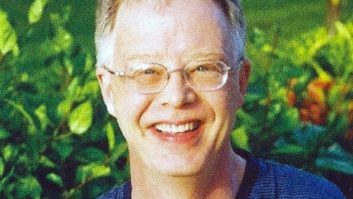Edward “Ed” Bench died at age 83 on Dec. 7, 2004, in Belleville, Ill. An engineer whose career dated to the Second World War, Bench had been honored as an SBE Fellow shortly before his death.
Geoffrey Mendenhall, vice president research and development for Harris Corp.’s Broadcast Communications Division, knew Bench for about 30 years.
“In the 1970s he was chief engineer at KCFM(FM), St. Louis and I was a design engineer for Harris at the time,” he said. “We worked together on a new FM exciter and we really valued his input and perspective. He helped us make sure the MS-15 performance and specs were what broadcast engineers wanted.”
The relationship between Mendenhall and Bench also went deeper.
“He was a kind and personable fellow,” said Mendenhall. “He was a good mentor with a lot of us at Harris and I kept in touch with him over the years.”
TV and radio
Ed Bench’s career began in 1942, when he was assigned to the Air Corps and soon became an aircraft radio operator. In 1944 he returned to school to further study radio and then cryptography, after which he married and settled in East St. Louis, Ill.
Beginning in 1948, he worked for various radio and TV stations in the area, making discoveries along the way.
“In 1951 he developed the first two-cavity antenna diplexer for TV,” said John Masters, chief engineer for KXEN(AM) in St. Louis, who knew Bench well. “Ed also solved the problem of Klystron tubes not lasting more than 1,000 hours by designing a proper beam current circuit.”
In 1959 Bench became interested in FM Special Carrier Authorization (SCA) transmission, refining and designing circuits while chief engineer at KCFM.
Masters said Bench went to Washington in March of 1960 to attend an NAB convention, and he obtained the specifications for the newly approved FCC stereophonic FM system. He soon built one, learning about envelope delay and phase linearity, refining the generator by adding variable phase shifters and frequency sensitive phase delays.
Bench presented his documentation to the commission in December of that year and received type approval for the “KCFM Colorsonic Stereo Generator CSG-1.” At midnight on June 1, 1961, KCFM made history by simultaneously signing on in stereo with two other FM stations in the nation. Manufacturers took note.
SBE honor
In addition to his radio achievements, Bench was a humanitarian. He worked with Jo Kathman, executive director of Radio Information Service for the Blind and Print Handicapped (RIS) at Our Lady of the Snows Shrine in Belleville, Ill., to design and manufacture sub-channel Pacesetter SCA receivers. He went on to help them remodel their studios. He was a member of the board of directors for many years.
He also was a co-founder of SAVE, a non-profit organization that helps special education students.
Ed Bench received recognition during his career but a final honor came in October 2004 in Marlborough, Mass., when he was named an SBE Fellow.
“I attended a meeting of Chapter 55 on Dec. 2 to present the award to him in person, but by that time he was unable to attend because of his poor health,” said John Poray, executive director of the Society of Broadcast Engineers.
A footnote came from the priest who officiated at Bench’s final mass. Ed Bench visited the priest several months prior and didn’t feel the church sound system was working properly. He insisted on fixing it.










